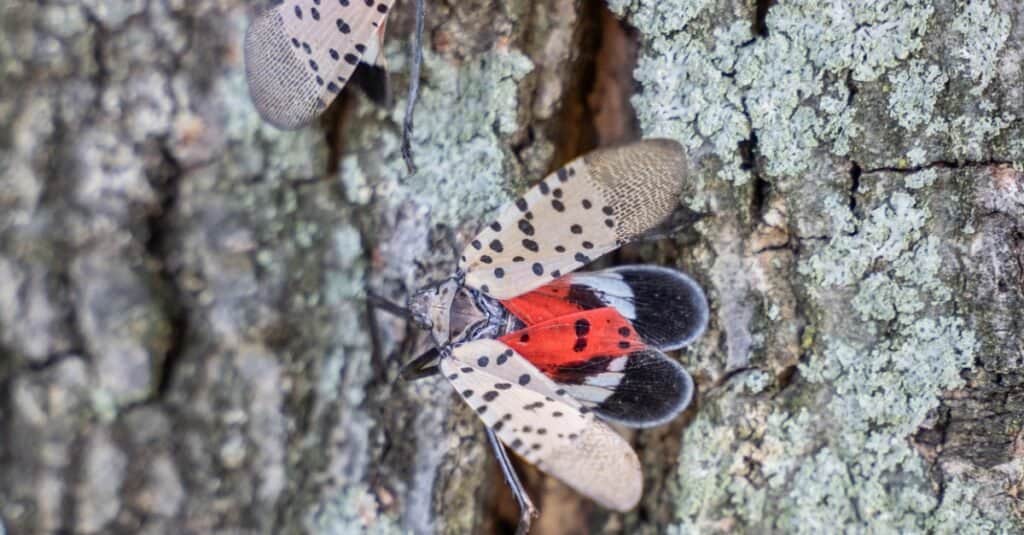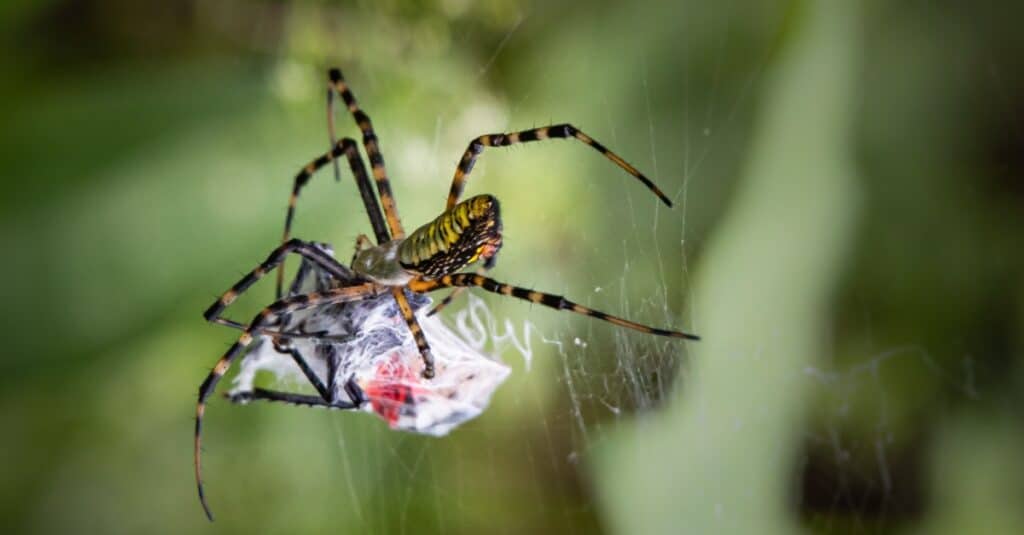What Animal Eats A Spotted Turtle Snakes Eating Pepople
Key Points
- Spotted lanternflies are an invasive species that take appeared in the eastern Usa despite being native to China, Vietnam, and Bharat.
- Predators of the spotted lanternfly include praying mantises, chickens, garden spiders, grey catbirds, yellowjackets, wheel bugs, garter snakes, and koi fish.
- The bugs' natural predators are limited, and spotted lantern flies pull a fast one on would-be predators, using their bright red wings to mimic the appearance of a poisonous insect.
Spotted lanternflies are native to China, Vietnam, and India. This insect is most one inch in length and one-half an inch wide. Its forewings are grayness with black spots. However, this insect is well-nigh notable for its brilliant red hindwings covered with blackness spots.
Spotted lanternflies are considered an invasive species and accept been institute in Pennsylvania, Connecticut, New York, Massachusetts, and Maryland along with other eastern states in the United States They live in copse and on a variety of plants that contain sap.
After consuming a tree's sap, spotted lanternflies release a liquid called 'honeydew.' This liquid is harmful because it attracts other destructive insects and can weaken a tree's defenses against mold and disease. Unfortunately, a big group of lanternflies is capable of killing a crop of fruit trees.
So, do spotted lanternflies have predators? These insects don't take a lot of natural predators, which is why they can multiply quickly and threaten fruit tree crops. Furthermore, the vivid red on this insect's hindwings serves every bit a warning signal to predators that information technology's potentially poisonous. This protects the bug from some threats. However, there are a few predators that eat these hopping insects.

Spotted Lanternfly Predators:
1. Praying Mantis
Praying mantises occupy many of the same areas as spotted lanternflies. A lanternfly eating the sap of a plant would probably not find a praying mantis sitting on or hanging below a nearby leafage. Praying mantises are bright light-green so they hands blend in with the leaves of many types of plants.
A praying mantis sits and waits for its lanternfly casualty to move closer. And so, in i swift movement, it grabs the insect using its spiked front legs. Praying mantis eat lanternflies and other prey with sharp mandibles that easily cut through the flesh of the insect.
Despite its name, the lanternfly hops more than information technology flies. And so, information technology doesn't accept a real chance of escaping a praying mantis that'due south hiding. Praying mantises eat adult lanternflies likewise equally young lanternflies known as nymphs.
two. Chickens
When you recollect of a group of farmyard chickens, yous probably picture them eating seed or cracked corn. But chickens have a reputation for eating lots of different types of insects. Spotted lanternflies are on a chicken's menu.
Since spotted lanternflies live on fruit trees and several types of plants, information technology wouldn't exist unusual for a craven in a farm environment to encounter this insect. A chicken that sees a lanternfly on the ground or on a plant will peck at it with its sharp beak. A large chicken could consume a whole lanternfly in one gulp. A smaller chicken would be able to swallow lanternfly nymphs.
iii. Garden Spiders

cwieders/Shutterstock.com
Garden spiders and spotted lanternflies alive in the same habitat. And then, it'due south no surprise that these spiders are on their list of predators. A garden spider spins its intricate spider web between stalks of plants and in other places where insects are plentiful.
The torso of a female person garden spider tin mensurate a picayune more than ane inch in length. So, they are large enough to subdue a lanternfly that'due south go entangled in their circular spider web.
Once a spotted lanternfly gets defenseless in its web, the garden spider injects it with venom causing it to finish moving. The spider may wrap the lanternfly in silk to eat subsequently or eat it right abroad.
iv. Gray Catbirds
Grey catbirds are also considered predators of spotted lanternflies. These birds live in meadows, thickets, and trees. This bird'due south name is a reflection of its distinctive call that sounds like a cat meowing.
They eat insects as well as berries and dissimilar types of pocket-size fruit. This makes an run into with a spotted lanternfly very probable. Gray catbirds can consume adult lanternflies or even a group of lanternfly nymphs on a tree or plant.
5. Yellow Jackets
Yellow jackets are attracted to vegetation with nectar and sap. They move around in the aforementioned habitat equally spotted lanternflies. Along with nectar, the diet of a yellowish jacket includes caterpillars and a diversity of insects.
A yellow jacket stings a spotted lanternfly with venom to immobilize it. Then it uses its mandibles to consume the insect. Scientists have observed yellow jackets eating both alive and dead spotted lanternflies.
vi. Wheel Bugs
Trees, gardens, and meadows are all habitats of the wheel bug. They eat caterpillars, beetles, and other insects. An adult bike problems can abound as long as i and a quarter inches. It gets its name from the bicycle-like appearance of its back.
This big insect captures a spotted lanternfly with its powerful front legs and holds its squirming body until it's dead. The cycle problems eats by poking its beak into a spotted lanternfly (or other insects) and draining its insides.
7. Garter Snakes

iStock.com/Robert Winkler
Garter snakes eat a variety of animals including minor rodents, pocket-sized fish, and insects. They have likewise been known to eat spotted lanternflies.
These snakes live in wooded areas, fields, and gardens. They are fast snakes that tin easily capture an adult lanternfly or lanternfly nymphs. This pocket-size snake grabs a spotted lanternfly in its strong jaws and swallows it whole.
Fortunately for the copse and natural habitats in the eastern United states of america, multiple types of garter snakes inhabit the region. The eastern garter snake is the most common garter snake in the states where the spotted lantern flies are invading, simply there are too shorthead garters in Pennsylvania and New York and common garters in Connecticut.
viii. Koi
Koi are colorful fish related to carp that can abound to a length of two feet or more — they're likewise Spotted Lanternfly predators. People with backyard ponds often stock them with these lively fish.
Though the koi in a backyard pond are usually fed food purchased from a store, they too eat insects. They are considered predators of spotted lanternflies. A spotted lanternfly that hops into a backyard swimming, or accidentally crash lands into one, will be gobbled upward past a koi in a matter of seconds!
Upwardly Next…
There's a lot more y'all should know about this troublesome bug. Check out some more posts and be on the lookout for the tree-devouring spotted lanternfly.
Spotted Lantern Fly Stages: What y'all need to know– These insects can await vastly different every bit they develop into adults, then be able to spot them no matter what!
How to Get Rid of Spotted Lanternflies– Save your garden and your community'due south trees from this pest.
What do Lanternflies Consume? 16 Foods in their Diet– Nosotros know what eats them, but which fruits and trees do they go afterwards?
Source: https://a-z-animals.com/blog/what-eats-spotted-lanternfly-do-they-have-predators/
Posted by: gravesexcums.blogspot.com

0 Response to "What Animal Eats A Spotted Turtle Snakes Eating Pepople"
Post a Comment